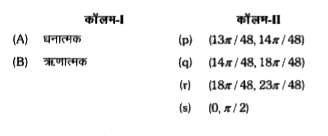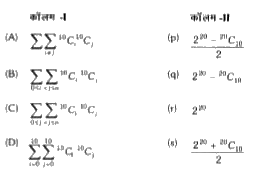यदि तीन परस्पर लम्बवत् रेखाओं की दिक् कोज्यायें (l1,m1,n1),(l2,m2,n2) व (l3,m3,n3) हैं, तो रेखा जिसकी दिक कोज्यायें l1+l2+l3,m1+m2+m3 व n1+n2+n3 हों, परस्पर कोण बनायेंगी
0∘
30∘
60∘
90∘
The correct Answer is:A
Step by step video, text & image solution for यदि तीन परस्पर लम्बवत् रेखाओं की दिक् कोज्यायें (l_(1),m_(1),n_(1)),(l_(2),m_(2),n_(2)) व (l_(3),m_(3),n_(3)) हैं, तो रेखा जिसकी दिक कोज्यायें l_(1)+l_(2)+l_(3),m_(1)+m_(2)+m_(3) व n_(1)+n_(2)+n_(3) हों, परस्पर कोण बनायेंगी by Maths experts to help you in doubts & scoring excellent marks in Class 12 exams.
Updated on:21/07/2023Topper's Solved these Questions
- त्रिविमीय निर्देशांक ज्यामिति Book:ERRORLESS HINDIChapter:त्रिविमीय निर्देशांक ज्यामिति Exercise:JEE ADVANCED (MORE THAN ONE CORRECT ANSWERS)
Explore 10 Videos
- त्रिविमीय निर्देशांक ज्यामिति Book:ERRORLESS HINDIChapter:त्रिविमीय निर्देशांक ज्यामिति Exercise:JEE ADVANCED (REASONIG TYPE QUESTIONS)
Explore 10 Videos
- त्रिविमीय निर्देशांक ज्यामिति Book:ERRORLESS HINDIChapter:त्रिविमीय निर्देशांक ज्यामिति Exercise:MULTIPLE CHOICE QUESTIONS (रेखा व समतल)
Explore 31 Videos
- त्रिकोणमितीय अनुपात, फलन एवं सर्वसमिकायेBook:ERRORLESS HINDIChapter:त्रिकोणमितीय अनुपात, फलन एवं सर्वसमिकायेExercise:JEE Advanced (Matrix Match type questions)
Explore 5 Videos
- द्विपद प्रमेय तथा गणितीय आगमन Book:ERRORLESS HINDIChapter:द्विपद प्रमेय तथा गणितीय आगमन Exercise:JEE Advanced (Matrix Math type questions)
Explore 5 Videos
Similar Questions
एक रेखा l जो मूलबिंदु से गुजरती है रेखाओं
l1:(3+t)ˆi+(−1+2t)ˆj+(4+2t)ˆk,−∞<t<∞
l2:(3+2s)ˆi+(3+2s)ˆj+(2+s)ˆk,−∞<s<∞
पर लम्बवत है। तब l2 पर स्थित बिंदु (बिंदुओं) के निर्देशांक जो रेखाओं l तथा l1 के प्रतिच्छेद बिंदु से √17 की दूरी पर है निम्न है: (i) (73,73,53) (ii) (−1,−1,0)
(iii) (1,1,1) (iv) (79,79,89)
View Solutionकथन-1: रेखा x1=y−12=z−23 में बिन्दु B(1, 6, 3) का दर्पण प्रतिबिम्ब (mirror image) बिन्दु A(1, 0, 7) है:
कथन-2: रेखा x1=y−12=z−23 बिंदुओं A(1,0,7) तथा B(1,6,3) को मिलाने वाले रेखाखण्ड का समद्विभाजन करती है।
View Solutionबिन्दुओ (2,-3,1) तथा (3-4,5) को मिलाने वाली रेखा समतल 2x+y+z=7 को जिस बिन्दु पर काटती है, वह बिन्दु है
View Solutionनिम्नलिखित कॉलम I को कॉलम II से मिलाये

View Solutionनिम्नलिखित कॉलम I को कॉलम II से मिलाये

View SolutionIf three mutually perpendicular lines have direction cosines (l_(1),m_(1),n_(1)),(l_(2),m_(2),n_(2)) and (L_(3),m_(3),n_(3)) then the line having direction cosines l_(1)+l_(2)+l_(3),m_(1)+m_(2)+m_(3), and n_(1)+n_(2)+n_(3) ,make an angle of
View SolutionLet l_(1),m_(1),n_(1);l_(2),m_(2),n_(2) and l_(3),m_(3),n_(3) be the direction cosines of three mutually perpendicular lines.Show that the direction ratios of the line which makes equal angles with each of them are (l_(1)+l_(2)+l_(3)),(m_(1)+m_(2)+m_(3)),(n_(1)+n_(2)+n_(3))
View SolutionShow that the matris ⎡⎢⎣l1m1n1l2m2n2l3m3n3⎤⎥⎦ is orthogonal,
ifl21+m21+n21=Σl21=1=Σl22=Σ23and
l1l2+m1m2+n1n2=Σl1l2=0=Σl2l3=Σl3l1.
View SolutionIf (l1,m1,n1),(l2,m2,n2) are D.C's of two lines, then (l1m2−l2m1)2+(m1n2−n1m2)2+(n1l2−n2l1)2+(l1l2+m1m2+n1n2)2=
View Solutionयदि (l1,m1,n1),(l2,m2,n2) और (l3,m3,n2) तीन परस्पर लब सरल रेखाओ कि दिककोज्याए हो तो सिद्ध कीजिए कि इन सरल रेखाओ से बराबर झुकी हुई एक सरल रेखा कि दिककोज्याए (l1+l2+l3√3,,m1+m2+m3√3,n1+n2+n3√3) होगी |
View Solutionयदि (l1,m1,n1),(l2,m2,n2) और (l3,m3,n3) तीन परस्पर लब सरल रेखाओ की दिककोज्याए हो , तो सिद्ध कीजिए की l1m2n2−m3n2=m1n2l3−n3l2=n1l2m3−l3m2=±1]
View SolutionLet l1,m1,n1,l2,m2,n2 and l3,m3,n3 are direction cosine of three mutually perpendicular line OA, OB and OC. If the direction cosines of OP are proportional to l1+l2+l3,m1+m2+m3,n1+n2+n3 and angle made by OP with lines OA, OB, OC are respectively θ1,θ2,θ3, then
View SolutionLet l1,m1,n1,l2,m2,n2 and l3,m3,n3 be the durection cosines of three mutually perpendicular lines. Show that the direction ratios of the line which makes equal angles with each of them are
(l1+l2+l3),(m1+m2+m3),(n1+n2+n3).
View Solution(l1,m1,n1),(l2,m2,n2),(l3,m3,n3) are the direction cosines of three mutually perpendicular lines. If the line, whose direction ratios are l1+l2+l3,m1+m2+m3,n1+n2+n3, makes angle θ with any of these three lines, then cosθ is equal to
View SolutionIf (l1,m1,n1),(l2,m2,n2) are d.c's of two lines then find the value of (l1m2−l2m1)2+(m1n2−n1m2)2+(n1l2−n2l1)2+(l1l2+m1m2+n1n2)2
View SolutionShow that the condition that tha concurrent lines with direction cosines (l1.m1,n1),(l2,m2,n2)and(l3,m3,n3) are coplanar is l1(m2n3−m3n2)+m1(n2l3−n3l2)+n1(l2m3−l3n2)=0
View Solution